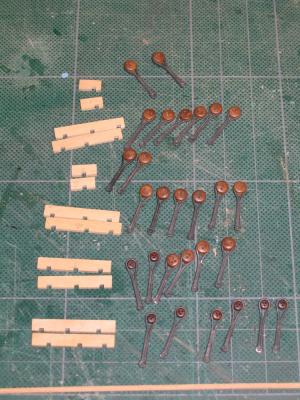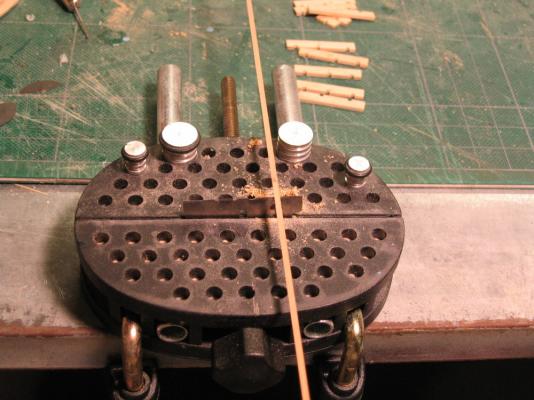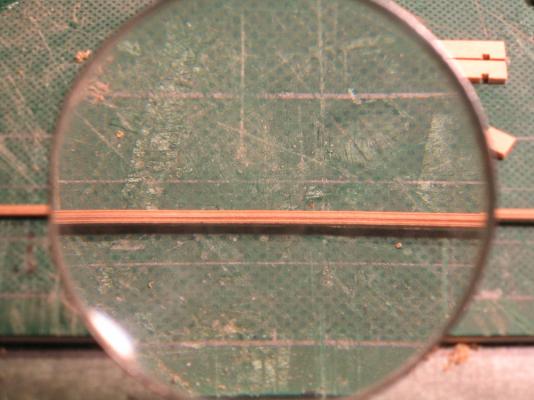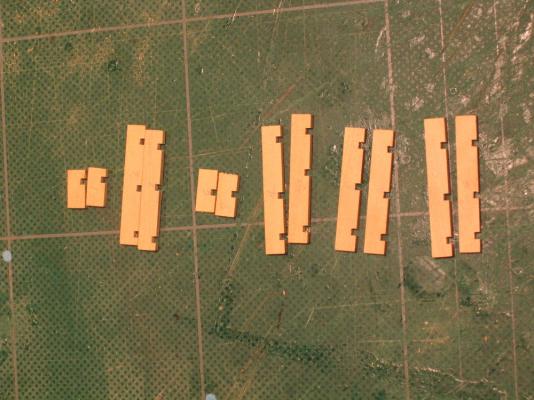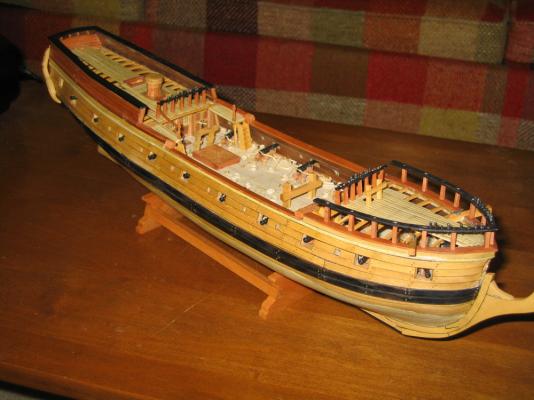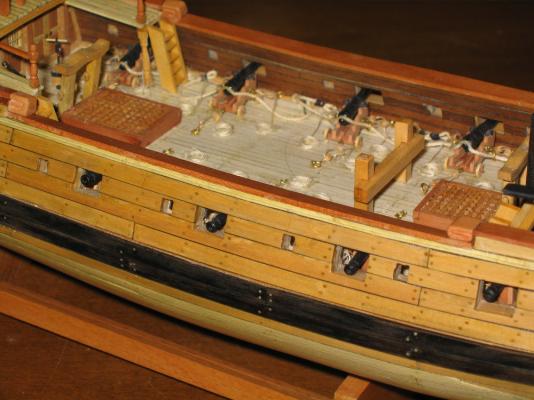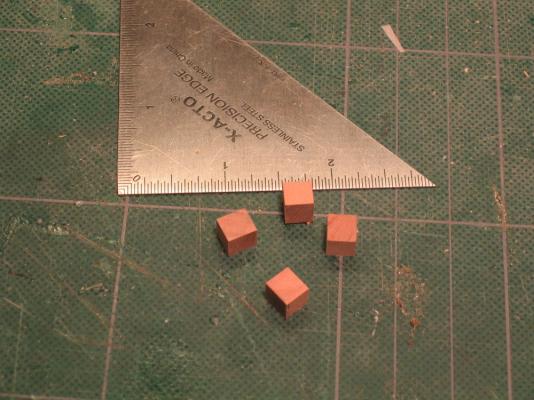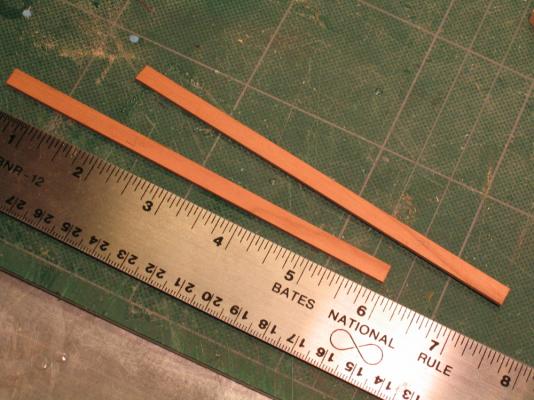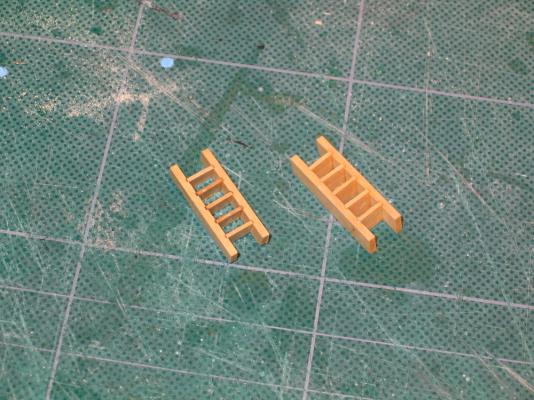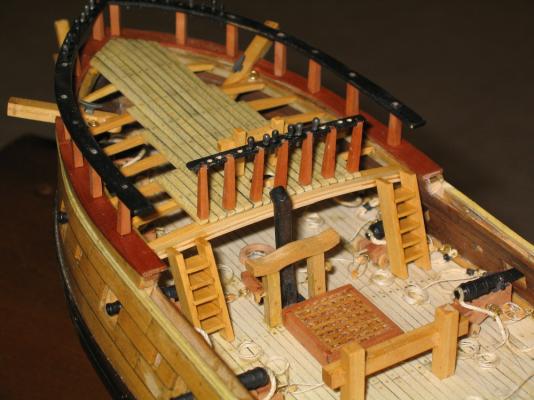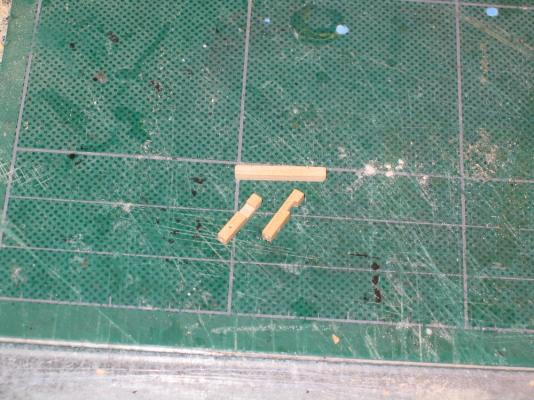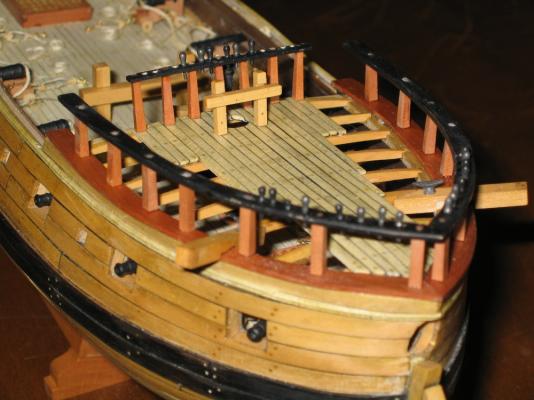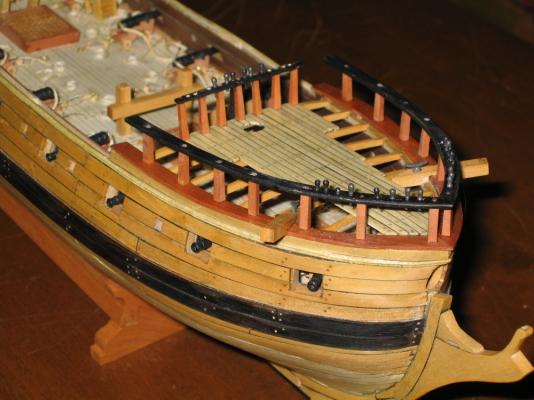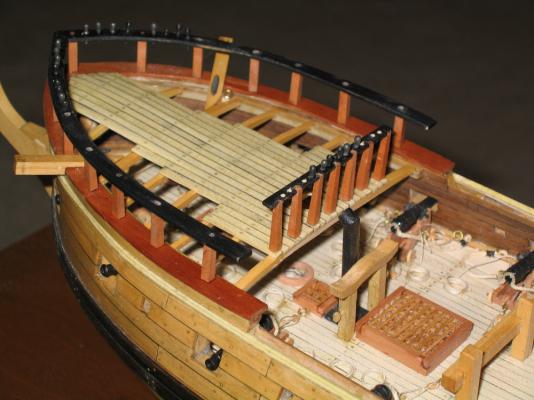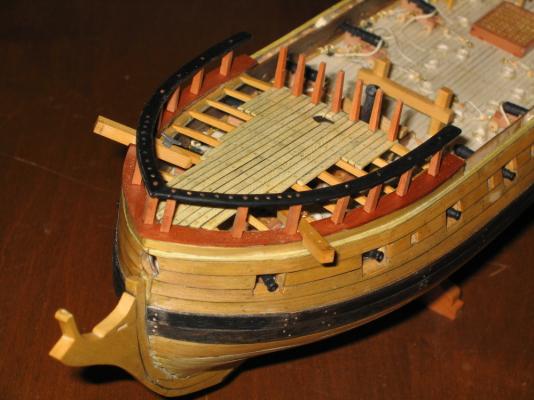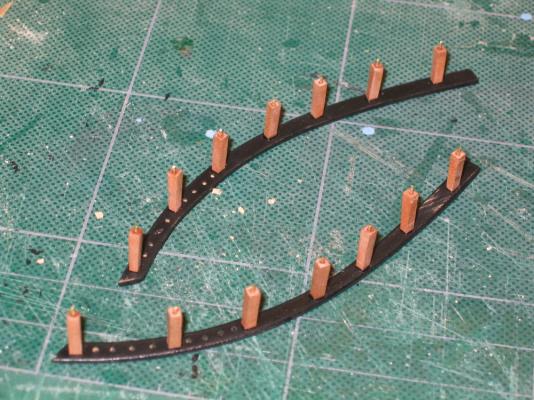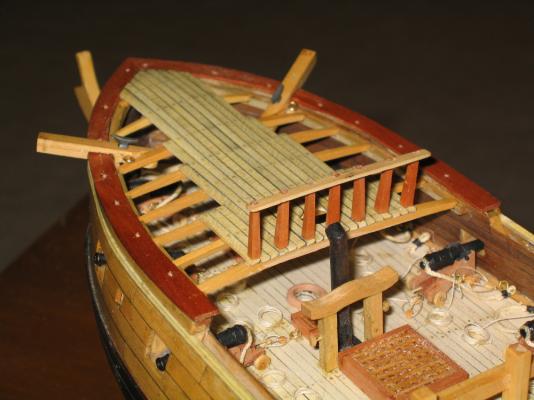-
Posts
2,612 -
Joined
-
Last visited
Content Type
Profiles
Forums
Gallery
Events
Everything posted by JSGerson
-
Not a bad idea. Since I'm still attaching them to the channels and they are not on the model I can still do that. Thanks for the tip.
- 974 replies
-
- rattlesnake
- mamoli
-
(and 1 more)
Tagged with:
-
The chainplates are made of Britannia metal which very soft and has the consistency of lead (without the lead). It is very easy to break. So very carefully the large loop of the chainplate was squeezed tight as much as I dared around each deadeye, eight of which were of a smaller diameter. The Practicum discusses how Mr. Hunt modified the kit’s chainplates to shorten them, but I didn't want to risk doing that. The channel moldings were made in the same fashion as my earlier moldings using a razor blade with the molding cross section cut into it. The wood strip was then drawn repeatedly over the cut area until the design was cut into the wood.
- 974 replies
-
- rattlesnake
- mamoli
-
(and 1 more)
Tagged with:
-
At this point the Practicum gives the builder a choice to either use the kit supplied chainplates or make their own. Based on the experience of Mr. Hunt and the need to solder very fine pieces, I chose to follow his lead and use the kit provided chainplates. They look a bit different from the Hahn’s plans, but it’ll work. Here an image of all the components necessary to create the channels.
- 974 replies
-
- rattlesnake
- mamoli
-
(and 1 more)
Tagged with:
-
CHAPTER 9 - Final Details The Channels Basically the decks are complete sans the rigging accoutrements; it’s time to work on the channels. The first thing I noticed was that the Practicum directs the construction of 6 channels per side. Looking at the Hahn’s plans, it shows only 5 (two in the bow and three at the aft end) while the Mamoli plans shows 6 (3 at each end). The channel in contention is the one which starts from the edge of the forecastle. As a two channel breaking over the gun port configuration, the first channel contains one deadeye and the second contains three. As a single channel, it contains all 4 deadeyes and spans over the gun port. To get a consensus of which way I should build them, I went looking at my collection of 44 different Rattlesnake models images (Mamoli, Model Shipway, scratch built and pre-assembled). Only two model-makers built their models with 5 channels (a very fine Hahn’s based POF and a pre-assembled), so it would appear the 6 channel configuration is the model of choice. So be it. Using 1/16” x 3/16” boxwood two pieces each of six lengths were cut per the Practicum. These were then placed on the drawing to determine where the 1/16” notch for the chainplates were located. As shown in the Practicum, I used the Byrnes saw with a .40” thick blade to cut a 1/16” notch. The Practicum called for a .057 thick blade, but I didn't have one. A fine diamond coated needle file will be used to get the extra width.
- 974 replies
-
- rattlesnake
- mamoli
-
(and 1 more)
Tagged with:
-
If you take a look at the Mamoli plan sheet No. 3, in the center right of the illustrations, it is part No. 107. On the Model Shipways plan (yes I finally received them) identified in the bottom right hand corner as "Plan-on Bulkhead Hull Construction" look at "section C-C" in the center of the drawing. The Hahn's plans don't address them. Somewhere I read that the gang planks were removed while out to sea, but those supports are something I wouldn't want run into during battle or in a storm.
- 974 replies
-
- rattlesnake
- mamoli
-
(and 1 more)
Tagged with:
-
I'm curious, when the sailors removed the temporary gangplanks, what happened to the supports that held them up? They look like metal right angle brackets mounted directly to the bulwarks. If they are left in place, wouldn't that be some sort of work hazard? I know they didn't have OSHA looking over their shoulders but those shipwrights did know how to build a ship! In other words, should I install the brackets without the gangplanks?
- 974 replies
-
- rattlesnake
- mamoli
-
(and 1 more)
Tagged with:
-
From what I understand, the temporary gangplanks were removed while the ship was at sea. The Practicum, based on Hahn's plans, does not address these. Some of the models I have images of show the temporary gangplank and some do not so at this point I have no plans to add them. If I did, I would have to move the ladders. They would also cover up the remaining cannon from view. Also some of the models show netting by the gangplanks. I'm not sure if that is part of the gangplanks or not so I'm not sure yet if I will try to make that.
- 974 replies
-
- rattlesnake
- mamoli
-
(and 1 more)
Tagged with:
-
It was all done with fine needle files (flat and V-shape) and a very fine chisel
- 974 replies
-
- rattlesnake
- mamoli
-
(and 1 more)
Tagged with:
-
- 974 replies
-
- rattlesnake
- mamoli
-
(and 1 more)
Tagged with:
-
- 974 replies
-
- rattlesnake
- mamoli
-
(and 1 more)
Tagged with:
-
Using scraps of swiss pear from the construction of the cannon trucks I fashion four ¼” cubes from which to carve the hances. (Remember, per the Practicum these were supposed to be put in when the gangplank was finished. At that point I explained why I didn’t) Once more my lack of experience has lead me to compromise. It turns out I did not pay attention to the angle of the rails in relationship to the deck. The waist rails should have been parallel to the forecastle and quarterdeck rails. Mine weren’t. As a result the hances are taller on the inside face than they are on the outside. The carvings were done to look like swirls. The Practicum claimed that the forward hances didn’t have any carvings on them, but per Hahn’s plans, you can’t tell as that area is covered with other detail. So I carved them to match the aft hances.
- 974 replies
-
- rattlesnake
- mamoli
-
(and 1 more)
Tagged with:
-
Before they were glued to the bulwarks, I glued some pieces of scrap wood inside and flush to the top of the walls to provide a solid gluing surface for the rails.
- 974 replies
-
- rattlesnake
- mamoli
-
(and 1 more)
Tagged with:
-
Main Waist Rails The main waist rails are made from two pieces of 1/16” x ¼” swiss pear. They were cut to length and trimmed as they narrow a bit at the ends. This was done with a series of dry fits.
- 974 replies
-
- rattlesnake
- mamoli
-
(and 1 more)
Tagged with:
-
Forecastle Ladders Ahh the ladders…again. These ladders, the fifth and sixth ones now, were made the same way as the quarterdeck ladders were done so I have had a little practice. I looked around for a nice simple ladder making jig, but they seemed more effort than I thought worth it for these last two ladders. Using the Brynes saw and meticulous measurements, I was able to produce the required slots in the ladder sides with the proper width, depth, and spacing. The saw blade was 1/32” thick exactly the thickness of the steps which meant I had to sand the steps a bit to allow them to slide into the slots. After moving a few cannon ropes, they were glued into place.
- 974 replies
-
- rattlesnake
- mamoli
-
(and 1 more)
Tagged with:
-
Forecastle Edge Piece Like the quarterdeck, I interpreted Harold Hahn’s plans to indicate there was an edge piece going from one deck clamp to the other for the forecastle. The Practicum did not address this at all. I have noted in other models, the maker did install it on theirs, so I did on mine. I was made in the same fashion as the quarterdeck
- 974 replies
-
- rattlesnake
- mamoli
-
(and 1 more)
Tagged with:
-
Forecastle Deck Bitts The forecastle deck bitts were made in the same manner as the brace bitts on the quarterdeck from 3/32" square boxwood. They are the same height. The only difference between these and the brace bits is that the measurement from the ends of the cross piece was 5/32" instead of 3/32".
- 974 replies
-
- rattlesnake
- mamoli
-
(and 1 more)
Tagged with:
-
I just ordered the MS plans - $12.50.(plus shipping $8.99) I finally got my sale!!!
- 974 replies
-
- rattlesnake
- mamoli
-
(and 1 more)
Tagged with:
-
Thanks for the picture. I really don't think the cleats are that important. It seems that everybody's model are a bit different for each other and who is to say which is correct. Ships change over time due to captain's whim, use, battle damage, and plain wear and tear. If I have to install them some time in the future, I could do it your way and place the cleats on the deck or smooth off the bottom (to avoid drilling) of the cleats and use just a fine dab of epoxy to apply it to the stanchions.
- 974 replies
-
- rattlesnake
- mamoli
-
(and 1 more)
Tagged with:
-
Since I don't have the MS plans yet (I'm still waiting for a sale that applies to them) I tried looking at the models that others have made for those cleats, especially MS models. I have images from 44 different models, 7 of which I know are from the MS kit. Of those that showed clearly the forecastle I couldn't get a clear view with enough detail to make out the referred cleats. Actually I'm not quite sure if you are referring to the forecastle center rail of the the Top Rail. In either case I couldn't see the cleats. Neither the Mamoli or the Hahn's plans show them as you have stated. If I add them, I'll have to wait until I get the MS plans.
- 974 replies
-
- rattlesnake
- mamoli
-
(and 1 more)
Tagged with:
-
Belay Pins Although the Practicum doesn't call for the belay pins to be installed at this stage, I thought it wise to do so while it was still free and clear of any other items that may be in the way later. The belay pins were insert and glued to the forecastle top rails. It was at this point I realized that I had forgotten to drill the belay pin holes in the forecastle center rail. Well, it wasn't done for the quarterdeck center rail and I had to drill those, so I hoped it wouldn't be too big a problem now. I marked to position for the holes with a pin and drilled pilot holes for eight pins in the quarterdeck center rail figuring the rail is a delicate structure. I didn't want to put too much pressure on it. Then I drilled the holes again so that the belay pins would fit. Surprisingly, this worked without a hitch. Once the forecastle center rail was solidly glued, the same process was repeated only this time there were only six belay pins according to the Practicum. What was weird here is the Practicum showed all three pins (per side) in between two stanchions. The Mamoli plan showed two pins. I went with the Mamoli plans because three pins seemed a bit crowded and two pin holes between stanchions also matched the quarterdeck center rail. I installed only six belay pins as per the Practicum. If need be I can install more as the holes for the pins have been drilled.
- 974 replies
-
- rattlesnake
- mamoli
-
(and 1 more)
Tagged with:
-
And before the CA glue completely set, both completed rail assemblies were installed onto the bow. This allowed me a little wiggle room to insert the brass pegs on the bottom of the stanchions into the holes on the bow and make any necessary adjustments. While the CA glue for the forecastle top rails was setting up, the forecastle center rail was installed.
- 974 replies
-
- rattlesnake
- mamoli
-
(and 1 more)
Tagged with:
-
The Forecastle Top Rail - Final With the forecastle top rail now dry, the stanchions were installed to the rails.
- 974 replies
-
- rattlesnake
- mamoli
-
(and 1 more)
Tagged with:
-
The rail was cut to length and notched just like I did for the quarterdeck center rail. It was then dry fitted to ensure proper installation. It was then painted black.
- 974 replies
-
- rattlesnake
- mamoli
-
(and 1 more)
Tagged with:
-
Forecastle Center Rail While the rails were drying, forecastle center rail stanchions were finally installed. You may remember I made those at the same time as the quarterdeck center rail stanchions.
- 974 replies
-
- rattlesnake
- mamoli
-
(and 1 more)
Tagged with:
About us
Modelshipworld - Advancing Ship Modeling through Research
SSL Secured
Your security is important for us so this Website is SSL-Secured
NRG Mailing Address
Nautical Research Guild
237 South Lincoln Street
Westmont IL, 60559-1917
Model Ship World ® and the MSW logo are Registered Trademarks, and belong to the Nautical Research Guild (United States Patent and Trademark Office: No. 6,929,264 & No. 6,929,274, registered Dec. 20, 2022)
Helpful Links
About the NRG
If you enjoy building ship models that are historically accurate as well as beautiful, then The Nautical Research Guild (NRG) is just right for you.
The Guild is a non-profit educational organization whose mission is to “Advance Ship Modeling Through Research”. We provide support to our members in their efforts to raise the quality of their model ships.
The Nautical Research Guild has published our world-renowned quarterly magazine, The Nautical Research Journal, since 1955. The pages of the Journal are full of articles by accomplished ship modelers who show you how they create those exquisite details on their models, and by maritime historians who show you the correct details to build. The Journal is available in both print and digital editions. Go to the NRG web site (www.thenrg.org) to download a complimentary digital copy of the Journal. The NRG also publishes plan sets, books and compilations of back issues of the Journal and the former Ships in Scale and Model Ship Builder magazines.



